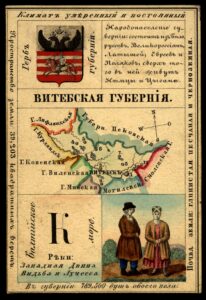Vitebsk Governorate
About Vitebsk
In the late 19th century, Vitebsk was a bustling Jewish center. The 1897 census documented that 52.4% of its residents were Jewish. The Jewish community was the economic backbone of the city, dominating commerce and crafts. However, this economic vitality existed alongside severe political and legal discrimination within the “Pale of Settlement.”
Read more…
This tension fueled a vibrant ideological struggle. On one hand, the socialist “Bund” gained significant power, organizing workers and artisans, and establishing armed self-defense groups against pogroms. On the other hand, the Zionist movement gained increasing influence, even penetrating the official communal establishment. Concurrently, the city became the cradle of modern Jewish art with the founding of Yehuda Pen’s art school in 1897. Pen and his students, led by Marc Chagall, sought to document and create a visual narrative for Jewish life in a changing world, similar to the ethnographic enterprise of S. An-sky, who documented the vanishing culture of the shtetl.
The Zionist movement flourished in Vitebsk. The early “Hibbat Zion” movement found a receptive audience in the city, and later, the socialist-Zionist “Poale Zion” party was established, founding a local branch between 1901–1903. The influence of Zionism was not limited to political circles but also permeated the official communal structure. A prominent example of this is the figure of Dr. Grigori (Tsvi Hirsch) Bruck, a notable Zionist leader who was elected in 1901 to the position of “state-appointed rabbi” (kazyonny ravvin) of Vitebsk. The appointment of an avowed Zionist to an official rabbinic post on behalf of the government attests to the deep penetration of Zionist ideas into the communal establishment. This influence was also expressed in tangible changes to the education system, as the traditional “Talmud Torah” was converted into a modern Hebrew school, a move that reflected the victory of nationalist ideas.
The Bolshevik Revolution ignited a brief but brilliant period of avant-garde creation in Vitebsk. Marc Chagall returned to his city in 1918 and was appointed Commissar for the Arts. He founded the “People’s Art School” based on a pluralistic vision, intended to allow for the expression of all artistic currents.
The arrival of Kazimir Malevich in the city in late 1919 changed the picture. Malevich, the father of Suprematism, established the “UNOVIS” group and promoted a dogmatic, collectivist, and abstract artistic and pedagogical approach, which stood in direct opposition to Chagall’s personal and figurative modernism. The struggle between the two over the soul of the school ended with Chagall’s departure in 1920, an event that symbolized the defeat of the revolution’s pluralistic vision in the face of a more rigid and totalitarian ideology.
In the 1920s, Vitebsk became a center for the “Yevsektsiya” (the Jewish section of the Communist Party), which led a top-down, forced revolution aimed at destroying all traditional Jewish communal structures. The Yevsektsiya conducted an aggressive campaign against Zionism, the Hebrew language, and religion, using the power of the state to close synagogues and traditional educational institutions. Concurrently, it promoted a secular and mobilized Soviet Yiddish culture.
On the economic front, after a temporary reprieve during the “New Economic Policy” (NEP), the pressure on Jewish merchants and artisans increased. Many of them were classified as “lishentsy” (disenfranchised) and stripped of their status. The end of the NEP and the beginning of Stalin’s “Great Break” in 1929 dealt the death blow to the traditional Jewish economic structure. Despite this repression, forms of Jewish life, such as the underground Chabad yeshiva, continued to exist in secret. Ironically, the Yevsektsiya itself was dissolved in 1930, after it had completed its role in eliminating Jewish civil society.
Vitebsk Province – back view of a card from the geographic card set illustrating all provinces of the Russian Empire as it existed in 1856. Each card presents an overview of a particular province’s culture, history, economy, and geography. Vitebskai︠a︡ gubernii︠a︡ (Vitebsk Province) depicted on this card corresponds to part of present-day Belarus. It contains a map of the province, the provincial seal, information about the population, and a picture of the local costume of the inhabitants. For the front view of the card and more information visit the Library of Congress Online Catalog






